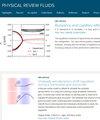磁流体动力学单元中圆周表面波的维持机制及其存在极限
IF 2.5
3区 物理与天体物理
Q2 PHYSICS, FLUIDS & PLASMAS
引用次数: 0
摘要
实验研究了低温镓合金在中心底电极和上环电极暴露于轴向磁场的不动池中的圆表面波(CSW)。结果表明,根据力参数和电池的几何特征[电池半径、液态金属(LM)层的高度和环形电极的位置],电池中可能出现三种模式:静止、CSW 或轴向旋转,表面上的深漏斗提供了 LM 与电极的圆形接触。在参数平面上绘制的模式图显示了 CSW 存在域的边界。提出了稳定 CSW 的存在机制。研究表明,CSW 是两个强烈大尺度涡旋的叠加。主涡旋的轴线与圆柱形电池的轴线重合,它是由位于底部电极附近的洛伦兹力产生的,是发散电流与垂直磁场相互作用的结果。第二个涡旋的强度要小一个数量级,旋转轴指向液态金属与环形电极的接触区域,出现在波峰附近。与主涡旋类似,它的存在是由于汇聚到接触区域的电流与叠加磁场的相互作用。第二个漩涡使 LM 在入射波前方升起。这两个涡旋的强度与外部磁场与总电流的乘积成正比,这也解释了表面振荡的相对频率与振幅之间的线性关系。本文章由计算机程序翻译,如有差异,请以英文原文为准。

Maintenance mechanism of a circular surface wave in a magnetohydrodynamic cell and limits of its existence
The circular surface wave (CSW) of a low-temperature gallium alloy in the immovable cell with a central bottom electrode and an upper ring electrode exposed to axial magnetic fields is studied experimentally. It is shown that, depending on the force parameter and geometrical characteristics of the cell [cell radius, height of the liquid metal (LM) layer, and position of the circular electrode], three modes can occur in the cell: rest, CSW, or axial rotation with a deep funnel on the surface providing the circular contact of the LM with the electrode. A mode map showing the boundaries of the CSW existence domain is plotted on the parameter plane. The mechanism which provides the existence of a stable CSW is suggested. It is shown that the CSW is a superposition of two intense large-scale vortices. The main vortex, whose axis coincides with the axis of the cylindrical cell, is generated by the Lorentz force localized near the bottom electrode and arising from the interaction of the divergent electric current with the vertical magnetic field. The intensity of the second vortex is an order of magnitude less, and the axis of rotation is directed to the contact area of the liquid metal with the ring electrode, which appears near the crest of the wave. Similar to the main vortex, it exists due to the interaction of the current converging to the contact area with the superimposed magnetic field. The second vortex provides the lifting of the LM ahead of the incoming wave. The intensity of both vortices is proportional to the product of the external field by the total current, which explains the linear relationship between the relative frequency of surface oscillations and their amplitude.
求助全文
通过发布文献求助,成功后即可免费获取论文全文。
去求助
来源期刊

Physical Review Fluids
Chemical Engineering-Fluid Flow and Transfer Processes
CiteScore
5.10
自引率
11.10%
发文量
488
期刊介绍:
Physical Review Fluids is APS’s newest online-only journal dedicated to publishing innovative research that will significantly advance the fundamental understanding of fluid dynamics. Physical Review Fluids expands the scope of the APS journals to include additional areas of fluid dynamics research, complements the existing Physical Review collection, and maintains the same quality and reputation that authors and subscribers expect from APS. The journal is published with the endorsement of the APS Division of Fluid Dynamics.
 求助内容:
求助内容: 应助结果提醒方式:
应助结果提醒方式:


